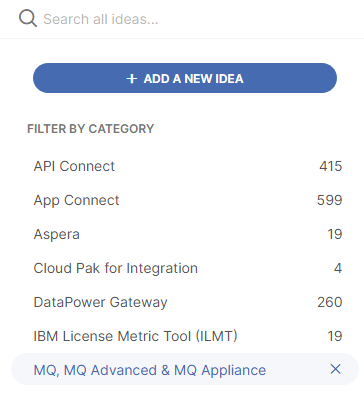The Request for Enhancement (RFE) system that lets you submit new requirements and ideas for IBM MQ has been moved to a new interface. Just about all IBM products are moving to use Aha! to give a common front-end, and it is now MQ’s turn to migrate.
This post is a quick look at what this means.
The interface
The original MQ requirements process was a hand-crafted approach based on emails and a Lotus Notes database. We then moved to a system that many (but not all) products participated in, hosted at this dW site. If you go there now, you will be pointed at new sites, called portals, which are used to manage requirements raised against groups of products. MQ is included in the “Integration” portal, found here.
You can use that site to open new ideas by clicking on the “Add a New Idea” box. Opening an idea requires, just as the dW site required, an IBM ID. Anyone can create one of those when it asks for you to login.
You can look at the requirement status without needing to login. You can also filter the displayed ideas to show just the MQ-related ideas by selecting that option. Just as before, you can add votes and comments to ideas that someone else has created.

There is more background on the IBM-wide migration and the reasons for it here.
The review process
Matt wrote about how requirements processing was evolving in this post in 2019. The way in which new requirements are reviewed and resolved is not being changed significantly from then. We have continued to try to reduce the backlog of requirements by being clearer about which ones have a chance of being implemented within the next couple of years – the furthest out we can make any predictions on.
My experience of submitted requirements is that most – not all – are “reasonable” ideas in that they make sense as possible enhancements to MQ. But as Matt wrote, a response does need to take into account the overall product priorities and available resources.
The differences
Just about all of the visible differences between the previous requirements system and the new one are in terminology. Partly that’s come from how the Aha product refers to things, and partly it’s a desire to have common meanings across all the IBM products using it. (There are lots of differences needed in the back-end processing, tools, and report generation that we use in MQ development when we look at the ideas, but those don’t affect how you use the system.)
So we now have “Ideas” instead of “RFEs”. The format of the reference has changed, so that an MQ Idea looks something like MESNS-I-999. Each product has its own prefix, MESNS is the one for MQ.
There have also been changes to how the status is reported:
- “Uncommitted Candidate” has become “Future Consideration”
- “Declined” has become “Not under consideration”
- “Duplicate” has become “Merged”
But essentially it’s the same thing.
We still look at items that have been closed with “not under consideration” and may change our minds at a later time. I know that has happened before; that response doesn’t mean we completely forget about an idea.
The migration
Existing unresolved RFEs (those that were under review or were uncommitted candidates) have been migrated to the new system. Looking at them on the old site shows a link to the new location. Other RFEs will still be available for now on the old site, and of course the product developers still have the information in our internal systems too.
I got a few notes from people who got a LOT of emails from Aha during the migration process that was over-enthusiastic about telling people what was going on. I apologise for that – there was something misconfigured in the gateways. But the admin team tell me that should now be fixed, so you should now only get notifications about relevant changes to items you have created or subscribed to. And now that the migrated data is tidied up, there should be fewer changes anyway.
Summary
Although the URL has changed, we still want people to raise requirements whether they are called RFEs or Ideas. They are valuable indications of how users want the product to evolve.
[Also published on the IBM Integration Community site here.]
This post was last updated on September 7th, 2021 at 02:33 pm
